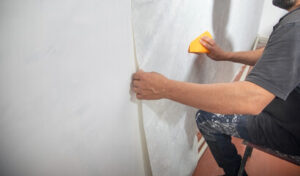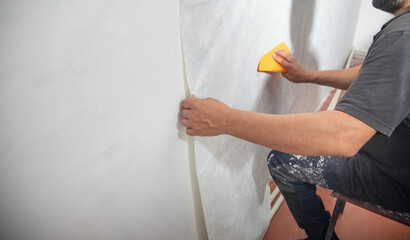Nashville Wallpaper Installers play a crucial role in transforming interior spaces with precision and creativity. A well-installed wallpaper can completely change the atmosphere of a room, adding texture, color, and depth in ways that paint alone cannot achieve. 
The process of wallpaper installation requires a combination of technical skill and artistic sensibility, as even the slightest misalignment or bubble can detract from the final appearance. Professional wallpaper installers have the expertise to handle a variety of materials, patterns, and surface conditions, ensuring that the finished result is both visually appealing and long-lasting.
The work of wallpaper installers begins with careful preparation, which involves assessing the wall surface, measuring the area, and selecting the appropriate adhesive and tools for the specific type of wallpaper being used.
Before the actual installation begins, wallpaper installers carefully inspect the wall surface for any imperfections, such as cracks, uneven textures, or moisture damage. These issues need to be addressed to create a smooth and stable foundation for the wallpaper. Sanding, patching, and priming are often necessary to ensure that the adhesive bonds properly and that the wallpaper adheres evenly without peeling or bubbling over time. Cleanliness is also important, as dust, dirt, or grease on the wall can interfere with the adhesive’s effectiveness. Once the surface is prepared, the next step involves precise measurement and cutting of the wallpaper to match the dimensions of the wall. This step requires attention to detail, especially when working with patterned wallpaper that needs to be aligned to create a seamless and consistent look.
The application process begins with the preparation of the adhesive, which may vary depending on the type of wallpaper. Some wallpapers come pre-pasted and only require water activation, while others require a specific type of adhesive to be applied to either the wall or the back of the wallpaper. Wallpaper installers use brushes, rollers, or spray equipment to apply the adhesive evenly, ensuring full coverage without excess material that could cause bubbling or warping. The wallpaper is then carefully positioned on the wall, starting from the top and working downward to avoid wrinkles and misalignment. Installers use smoothing tools, such as brushes and plastic spatulas, to press the wallpaper into place and remove any air pockets or creases.
Seams and edges require special attention to ensure a flawless finish. Professional wallpaper installers carefully align the edges of each strip of wallpaper to create a seamless appearance. Overlapping or misaligned seams can be visually distracting and may cause the wallpaper to peel over time. To prevent this, installers use sharp utility knives to trim excess material and create clean, precise edges. Corners and junctions between walls are particularly challenging areas that require careful handling to avoid gaps or bulging. Experienced installers use techniques such as double cutting, where two overlapping strips are cut simultaneously to create a perfect seam, ensuring that the pattern continues smoothly from one strip to the next.
Patterns and textures add an extra layer of complexity to wallpaper installation. Geometric designs, florals, and intricate motifs require careful alignment to maintain visual consistency. Even a minor deviation can disrupt the overall pattern and create an uneven or chaotic look. Professional wallpaper installers use laser levels, measuring tapes, and plumb lines to maintain accuracy and ensure that the design flows smoothly across the wall surface. Textured wallpapers, such as grasscloth or embossed materials, present additional challenges because they require gentle handling to avoid damage or distortion. Installers often use soft brushes and specialized rollers to work with these delicate materials, ensuring that the texture remains intact while achieving a secure bond with the wall.
The choice of wallpaper material influences the installation process and the final outcome. Vinyl wallpapers are popular for their durability and resistance to moisture, making them suitable for high-traffic areas and spaces prone to humidity, such as kitchens and bathrooms. Fabric-backed wallpapers offer a luxurious look and feel but require specialized adhesives and careful handling to avoid stretching or fraying. Metallic and foil wallpapers reflect light and create a striking visual effect, but they highlight imperfections in the wall surface and require a perfectly smooth substrate for optimal results. Peel-and-stick wallpapers provide a convenient option for temporary or removable designs, but they require precise alignment and careful application to prevent bubbling and peeling.
The removal of existing wallpaper is often a necessary step before installing new material. Professional wallpaper installers use steamers, chemical strippers, and scraping tools to remove old wallpaper without damaging the wall surface. This process requires patience and care, especially when dealing with multiple layers of wallpaper or adhesive residue. Once the old wallpaper is removed, the wall surface must be cleaned, sanded, and primed to create a suitable foundation for the new installation. In some cases, repairs may be needed to fill in holes, cracks, or uneven surfaces before proceeding with the installation of the new wallpaper.
Environmental factors such as temperature, humidity, and lighting can influence the installation process and the long-term performance of the wallpaper. High humidity can cause the adhesive to soften and weaken, leading to peeling or warping. Excessive heat can cause the adhesive to dry too quickly, making it difficult to adjust the wallpaper’s position and alignment. Professional installers take these factors into account when planning and executing a wallpaper installation, ensuring that the room’s environmental conditions are suitable for the type of wallpaper being used. Proper ventilation and temperature control during and after installation help prevent moisture buildup and ensure that the adhesive sets properly.
Cleaning and maintenance are essential to preserving the appearance and longevity of wallpaper. Vinyl and washable wallpapers can be wiped down with a damp cloth and mild detergent to remove dust and stains. Fabric-backed and textured wallpapers require more delicate care, such as vacuuming with a soft brush attachment or spot-cleaning with a gentle cleanser. Moisture and direct sunlight can cause fading and discoloration over time, so installers often recommend using window treatments or UV-blocking coatings to protect the wallpaper from environmental damage. Professional installers also provide guidance on how to address minor damage, such as tears or lifting seams, to maintain the wallpaper’s pristine condition.
The expertise of wallpaper installers extends beyond technical skills to include creative and aesthetic insights. They work closely with clients to select patterns, colors, and textures that complement the overall design of the space. They offer advice on how to use wallpaper to highlight architectural features, create focal points, or balance the visual proportions of a room. Experienced installers understand how to adapt their techniques to different styles and design preferences, ensuring that the finished result reflects the client’s vision while maintaining professional quality standards.
Wallpaper installation requires a combination of precision, creativity, and problem-solving. Every wall presents unique challenges, from uneven surfaces and complex patterns to environmental factors that affect adhesion and durability. Professional wallpaper installers have the experience and training to anticipate and address these challenges, ensuring that the wallpaper is applied smoothly and securely. Their attention to detail and commitment to quality contribute to the overall success of the project, creating a finished result that enhances the beauty and comfort of the space. Investing in professional wallpaper installation ensures that the wallpaper not only looks stunning but also stands the test of time, providing long-lasting style and visual appeal.
